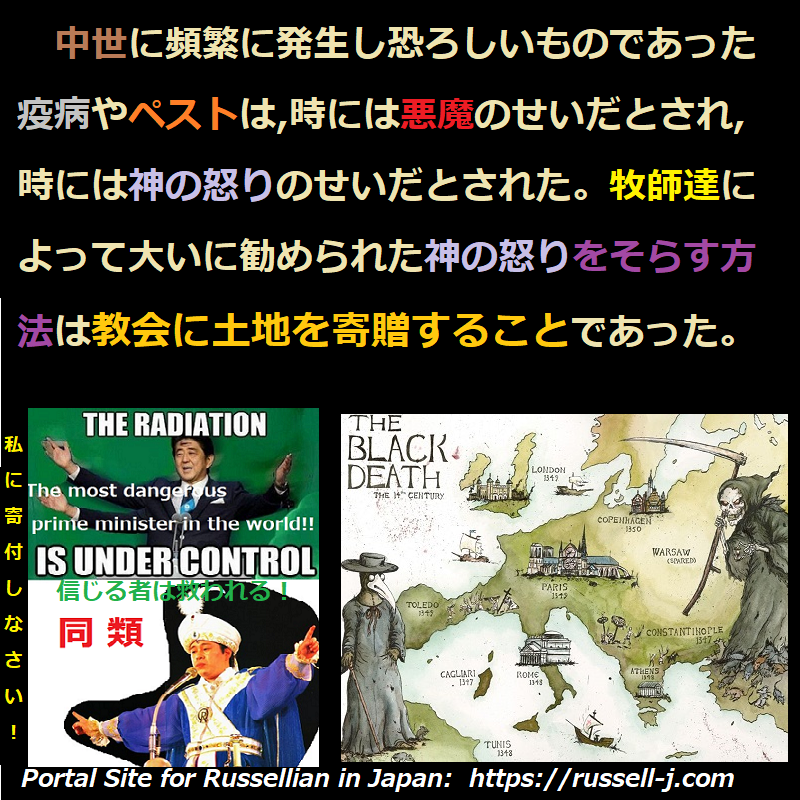
奇蹟的治癒は、カトリック(旧教徒)と同様,プロテスタント(新教徒)の人たちにも信ぜられた。(英国の)イングランドにおいては,国王が(患者に)触れることによって,「王の病」の呼称で知られていた病気(注:瘰癧/るいれき= リンパ腺の病気)を治し,かの聖人君主のチャールズ二世は,約10万の人々に触れた(と言われている)。国王陛下の外科医はそのようにして効果のあった60件の治癒(例)の説明を公表した。また、他の外科医は、国王が触れることによって治った何百もの治癒(例) -それらの多くは最も有能な外科医がさじを投げたもの(治すことができなかったもの)- を自分の目で見た(と彼らは言っている)。祈祷書(the Prayer Book)の中には、その奇蹟的な治癒力を行使する時に行われた特別な礼拝(a special serevice)が載っている。これらの力は、ジェームス二世、ウイリアム三世,アン女王へと(順に)受け継がれたが,みたところ,そのような奇蹟の力もハノーバー家の王位継承よりも生き延びることは出来なかったようである。(注: unable to survive the Hanoverian succession ハノーバー家が断絶したら,そういった力も一緒に消えてしまった/他に引き継がれることはなかった。) 中世に頻繁に発生し恐ろしいものであった疫病やペストは、時には悪魔のせいだとされ、時には神の怒りのせいだとされた。牧師たちによって大いに勧められた神の怒りをそらす方法は,(キリスト)教会に土地を寄贈することであった。1680年、ローマに疫病が流行した時、疫病流行は(それまで)不当に無視されてきた聖セバスチャン(注:セバスティアヌスとも表記される。キリスト教の聖人・殉教者で,3世紀のディオクレティアヌス帝のキリスト教迫害で殺害されたと言われている。)の怒りによるものだと主張された。記念碑が彼のために建てられ,そうして疫病の流行は止まった。1522年,ルネッサンスの最盛期において、ローマの人々は当時ローマ市を襲っていた疫病(の原因)を当初誤診した。ローマ市民はその原因は悪魔即ち古代の神々の怒りによると考え、コロセウムでジュピターに(1頭の)雄牛を捧げた。これが全く無益であると分ると、彼らは聖母マリアと聖人たち(the Virgin and the saints)を宥めるための行列聖歌(processions)(の慣行)を制度化した。これは彼らも当然知っているべきであったが、はるかに効果的であった。
Chapter 4: Demonology and Medicine, n.4
Miraculous cures were believed in by Protestants as well as Catholics. In England, the king’s touch cured what was known as “the King’s evil,” and Charles II, that saintly monarch, touched about 100,000 persons. His Majesty’s surgeon published an account of sixty cures thus effected, and another surgeon himself saw (so he says) hundreds of cures due to the king’s touch, many of them in cases which had defied the ablest surgeons. There was a special service in the Prayer Book provided for occasions when the king exercised his miraculous powers of healing. These powers duly descended to James II, William III, and Queen Anne, but apparently they were unable to survive the Hanoverian succession. Plagues and pestilences, which were common and terrible in the Middle Ages, were attributed sometimes to demons, sometimes to the wrath of God. A method of averting God’s anger, which was much recommended by the clergy, was the gift of lands to the Church. In 1680, when the plague raged at Rome, it was ascertained that this was due to the anger of St. Sebastian, who had been unduly neglected. A monument was raised to him, and the plague ceased. In 1522, at the height of the renaissance, the Romans at first made a wrong diagnosis of the plague then afflicting the city. They thought it was due to the anger of the demons, i.e. of the ancient gods, and therefore sacrificed an ox to Jupiter in the Colosseum. This proving of no avail, they instituted processions to propitiate the Virgin and the saints, which, as they ought to have known, proved far more efficacious.
出典:Religion and Science, 1935, chapt. 4:
情報源:https://russell-j.com/beginner/RS1935_04-040.HTM
